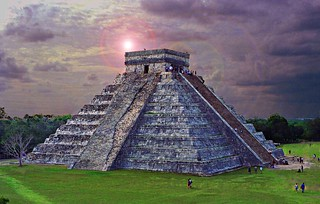The Mayan Civilization was a compelling civilization that can be traced back to ~1800 B.C.E. mainly located in the Yucatan Peninsula in modern-day Mexico.

Early Maya (~1800 B.C.E – 250 C.E.)
Many early Mayans were farmers working to grow crops such as corn, squash and beans. The Mayans were heavily influenced by their neighbors especially the Olmec Empire, they used the Olmecs calendar, and numbers.
The Early Mayans had a written language and the wrote by inscribing into stone tablets similar to the Mesopotamians. They also built pyramid like monuments although the materials used and the style they were built in were fairly different from the Ancient Egyptian pyramids.
Although there are many similarities between the Mayans and other civilizations it is unlikely that the Mayans had contact with these other civilizations as they were located in the Americas that weren’t close to Asia, Africa, and Europe where most other civilizations at the time lived.
Classic Maya (250 A.D. – 900 A.D.)
The Classic Mayan Period is often considered the Mayan golden age. During this time the Mayan civilization could have been home to two to ten million citizens.
To support the large population many Mayans worked as farmers to supply the Mayans with enough food. The used many agricultural methods such as irrigation, terracing, and the slash and burn method. The slash and burn method is when farmers cut down large forests to make space for large farms.
The Mayans also thrived in sports as they played a famous ball game known as Pok-Ta-Pok. It was game played with two teams, the winning team would win riches and slaves while the losing team would be sacrificed the Mayan gods.
Religion was very important in Mayan society. The Mayan religion was polytheistic meaning it was made up of multiple gods and goddesses. The kings of the Mayan were believed to have been related to the gods. They performed ceremonies and rituals to please the gods hoping they would bring things such as rain or a good harvest. These rituals were often done in large temples and included animal and human sacrifices.

(The Chichen Itza, A famous Mayan temple)
The Post Classic Period (900 C.E. – 1500 C.E.)
The Post Classic Period marked the end of the Maya golden age. For reasons that we are still unsure about today many Mayan cities were abandoned. Many speculate this could be due to a lack of food and resources to compensate for the growing population. Other think it may have been due to constant wars and rivalries between Mayan cities, or a devastating drought that may have occurred leading to a mass water shortage.
Although most of the Mayan cities fell some such as the Chichen Itza, Mayapan, and Uxaml continued to survive and even thrive up until the arrival of the Spanish colonizers in ~1500 C.E. Spanish colonizers.
Citations:
“Mayan Civilization: Calendar, Pyramids and Ruins | HISTORY.” History.com, 21 July 2022, www.history.com/topics/ancient-americas/maya.
López, Mónica Ramírez. “A Brief History of the Mayan Ball Game.” Culture Trip, 10 June 2017, theculturetrip.com/north-america/mexico/articles/a-brief-history-of-the-mayan-ball-game.
Leave a comment